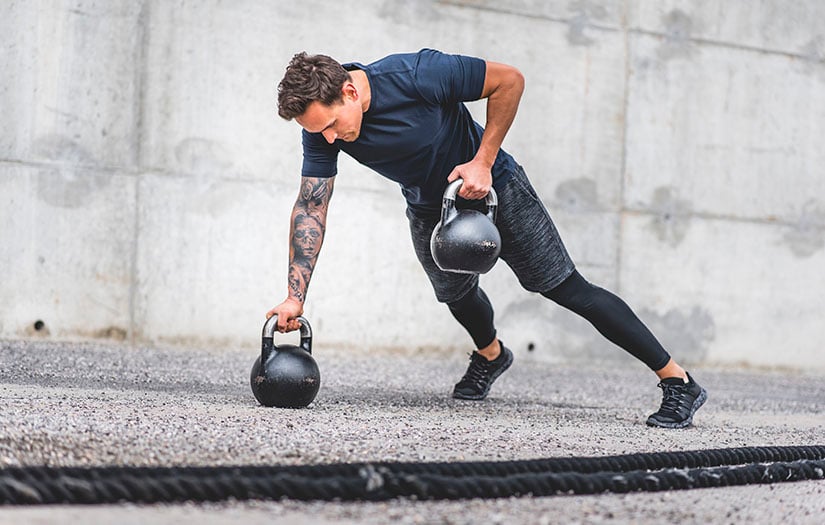It's not uncommon to see kettlebells at any gym, studio, or fitness equipment retailer near you. Even though kettlebells have been around for over 1,000 years, they only became popular for the average fitness consumer and personal trainer in the last 20 years.Kettlebell workouts have gained popularity over the years because of their effectiveness in building strength and burning calories with minimal equipment (often just a single kettlebell will do). However, it's not just the kettlebell itself, but how you use it that gets the results.
Why Are Kettlebell Workouts So Effective?
Simply put, kettlebells offer the perfect recipe for an effective and efficient exercise routine! If all you had was one kettlebell, you could do a full-body workout in a relatively small space.
Kettlebell workouts are designed to help you build strength using the resistance of the kettlebell and burn calories using multi-joint compound moves that keep the heart rate elevated. You can quickly transition from one exercise to the next to minimize rest, maximize results, and decrease the overall time that you spend working out.
Kettlebell Workout Routine
Kettlebells can be used for any phase of training, whether it be Stabilization, Strength, or Power. This workout is geared toward strength training in Phase 3 of the NASM OPT Model: Muscular Development Training.
Note: It's recommended to complete Phase 1 and 2 training (Stabilization Endurance and Strength Endurance, respectively) to build a stable base before attempting a Phase 3 workout.
Reps, Sets, and Days to Workout
Acute Variables: Perform 6-12 reps of each exercise for 3-6 sets at a medium tempo with 0-60 seconds rest between exercises.
Using these acute variables and the workout routine listed below, you can exercise 2-3 times per week, with a day off in-between training sessions for adequate recovery.
The Workout:
• KB Supine Chest Press
• KB Goblet Squat
• KB Alternating Bent Over Row
• KB Deadlift
• KB ½ Kneeling Overhead Press
• KB Front Squat
• KB Farmer's Carry
Kettlebell Exercise Demonstrations
These exercises can be performed with one or two kettlebells, depending on what you have available. If you only have one kettlebell, choose the number of reps (aiming for 6-12, although up to 20 reps can be performed if good form allows it) that you can perform for each exercise with good form for each movement.
For example, you'll find that you may not be able to do as many ½ Kneeling Overhead Presses as you can Goblet Squats with the same weight.
Kettlebell Supine Chest Press
Lay flat on your back with your knees bent and feet flat on the floor. Grasp the handle of the kettlebell so that the belly of the bell is behind your arm, resting on your forearm.
Brace your core as you press straight up toward the sky and then lower until your elbow is hovering just above the floor. Keep the elbows 45-degrees out from your trunk- not in, and not straight out to the side.
You can perform this one with one kettlebell, with two kettlebells working simultaneously, or with two kettlebells alternating for an additional core challenge.
Kettlebell Goblet Squat
Hold one kettlebell by the handle at chest height and pull it close to your body.
Stand with your feet between hip to shoulder-width apart with the toes pointed forward.
Brace your abs and lower into a squat, going as low as you can keeping your back flat and your chest up.
Squeeze the glutes as you stand, returning to a tall standing position before starting the next rep.
KB Bent Over Row
Hold one or both kettlebells at your side (if using two, hold one kettlebell on each side).
Stand with your feet hip-width apart and keep your back flat as you hinge forward to get your back as close to parallel to the ground as you can get it without rounding forward.
Hold this position and keep your abs tight as you row your wrist toward your ribcage.
If you have one kettlebell, perform all reps on one side before switching. If you have two, you can row both at the same time, or alternate for an additional core challenge.
Kettlebell Deadlift
Stand with your feet hip to shoulder-width apart with a kettlebell between your feet.
Keep your back flat as you hinge at the hips and bend the knees to grasp the handle of the kettlebell with both hands.
Brace your core and squeeze the glutes to stand while holding the kettlebell.
Repeat this move for the desired number of reps, going as low as you can without rounding your back. If starting at the floor is too low, place the kettlebell on an elevated surface to start.
KB ½ Kneeling Overhead Press
Start with one knee on the ground and the other bent in front of you at 90-degrees.
Rack one or both kettlebells at the shoulder by keeping the thumbs close to the shoulders and the elbows in. The kettlebell should rest on the outside of your arm.
Brace your core and exhale as you press the kettlebell straight up toward the sky. As you press up, your arm should be next to your ear (not drifting forward).
Try pressing one arm at a time, or you can challenge yourself with an alternating press if you've got two kettlebells.
Kettlebell Front Squat
Rack one or both kettlebells at the shoulder by keeping the thumbs close to the shoulders and the elbows in. The kettlebell should rest on the outside of your arm.
Stand with your feet hip-width to shoulder-width apart and brace your core as you lower into a squat.
Keep your chest tall and squat as close to parallel (or slightly below) as you can with good form.
KB Farmer's Carry
Hold a heavy kettlebell at your side and stand tall with a good posture.
Brace your core and begin walking, focusing on keeping good posture and not letting your body lean to one side.
After taking 10-20 steps, switch arms and repeat.
For an added core challenge, try this move with two kettlebells of different weights- one on each side!
Is it Ok to do Kettlebells Every Day?
When putting together your weekly workout plan, the intensity and variety of your workouts will determine whether your work out with your Kettlebells each day. If you only know one routine and you hit it hard, your body will likely benefit from a rest day or two from that same activity. If you target different muscle groups each day, then it's perfectly alright to use your Kettlebells every day.
Vary the intensity of your workouts throughout the week (incorporating some low, medium, and even high-intensity days) to keep your workout schedule balanced and to avoid over-training. The main key is to listen to your body. If you're feeling tired and run down, it's best to take a rest day.
Are There Cons to Kettlebell Workouts? Is it Bad for You?
Just like any other workout, proper form and progression are key to avoiding unnecessary injuries. Because there are so many kettlebell workouts floating around the internet, it can be easy to attempt a more advanced routine without a good base of training, which could lead to injury.
Some advanced kettlebell moves (like kettlebell snatches, for example) require significant skill and practice to master. Inexperienced kettlebell users may end up with some bruises on their arms or body from attempting more advanced moves without proper training. Seeking the help of an experienced trainer or coach can help you avoid these common pitfalls.












